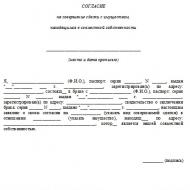
What is a letter of credit. What is a letter of credit from a bank when buying an apartment? Scheme for issuing a bank letter of credit
Hello! In this article we will talk about the system of payments using letters of credit.
Today you will learn:
- Where can a letter of credit come in handy?
- What types of letters of credit are most common;
- How to draw up an agreement using a letter of credit;
- How to use a letter of credit.
Letter of credit: the essence of the concept
The business sphere is full of not only conscientious companies that operate in accordance with the law and the terms of the contract. There are also scammers whose main goal is to leave the counterparty with nothing. You give them a product or money for it, but as a result you are left without both.
However, expanding the production volume of an enterprise implies that it will cooperate with new business partners, whose integrity is not always possible to verify.
What to do if you enter into an agreement with a company unknown to you and are worried about the outcome of the transaction? What should you do if the other party is late in payment or if goods are not shipped in response to your advance? Such issues and resulting problems are easily resolved with the help of a letter of credit.
Letter of Credit is a special settlement system that guarantees both parties to the transaction a positive outcome. This banking product with the participation of two banks: in the first an account is opened for the seller, and in the second for the buyer. The credit institution transfers funds from the account only if the terms of the agreement between the parties to the transaction are fulfilled and supporting documents are provided.
A letter of credit implies the presence of two participants in addition to banks:
- Applicant (or buyer);
- Beneficiary (seller).
The initiator of the contract is the buyer. It is he who is interested in receiving the object of the transaction, and therefore applies to the bank with an application to open a letter of credit.
This service is provided on a fee basis: banks charge commissions, which in some cases are quite impressive. However, a letter of credit is a guarantee of contract performance, which plays an important role for both parties to the agreement.
The buyer's bank will transfer funds to the seller's account only if the terms of the signed agreement are fulfilled (for example, when goods are shipped). If the seller violates the terms of the agreement, the bank will return the funds to the buyer’s account.
A letter of credit is a rather complicated operation that requires complex processing. However, it is very popular, as it is the key to successful cooperation between participants in various transactions.
For which payments is a letter of credit used?
A letter of credit is a fairly universal concept that can be used in transactions between:
- Individuals.
Legal entities are the main users of such banking services. Often, transactions involve companies whose names are not well known, and therefore one of the parties to the transaction tries to hedge their bets.
One company supplies the goods, and the second acquires them. A letter of credit allows them to avoid controversial situations when making payments. The same applies to the provision of various services or performance of work.
Individual entrepreneurs can also offer the counterparty to issue a letter of credit if they doubt its reliability. When planning the shipment of goods to a large sum It is better to fix the settlement process in a very clear agreement so as not to lose your own funds.
The use of letters of credit is also common among individuals. Most often he accompanies large purchases. For example, you. A seller has been found, however, for some reason you doubt that he will fulfill his obligations under the contract.
To be sure of his integrity and accurately receive funds from the sale, you should contact the bank and conclude an agreement on the terms of a letter of credit. Most often, scammers immediately disappear with such offers, since the bank will require them to deposit the full amount into their account.
If the buyer is a decent person, then no problems arise in the process of issuing a letter of credit.
The essence of a letter of credit is the same for different parties to transactions: the fulfillment of obligations under it is insured. The use of this banking service is relevant to any items of purchase and sale: from small goods to expensive real estate.
Types of letters of credit
Letters of credit are a payment instrument used not only for domestic trade.
Based on this, there are two types of it:
- International (applied for transactions involving export or import);
- Domestic (used exclusively for purchase and sale within the country).
Letters of credit can also be distinguished:
- Revocable. You can cancel an already opened letter of credit at any time by one of the parties to the transaction. However, this type of calculation is extremely unreliable and does not inspire confidence among market participants. Therefore, their use is limited in our country. regulations. This is done in order to avoid fraudulent activities one of the parties to the agreement;
- Irrevocable. Once a letter of credit has been signed, it cannot be cancelled. This type of calculation gives confidence to the parties to the transaction in its successful outcome.
Depending on the terms of the transaction, letters of credit are divided into:
- Confirmed. In this case, the executing bank (the one that transfers funds to the seller’s account) offsets the money to the second party to the transaction, even if there is no money in the account. In other words, the bank is looking for a third party to the transaction as credit organization, which will transfer the required amount upon fulfillment of the terms of the agreement. However, in this case, the executing bank bears the risk of non-return of the transferred funds. As a result, this form of letter of credit is not used very often;
- Unconfirmed. Transfer of funds to the second party of the transaction is carried out only if there are funds in the account. Banks prefer this form of payment to avoid losing their own money.
The procedure for writing off funds divides letters of credit into two types:
- Coated. The issuing bank transfers funds to the nominated bank when the agreed conditions are met. The amount credited is called coverage, which is where the name letter of credit comes from. The covered form of payment is used exclusively in Russia;
- Uncovered. The issuing bank gives the nominated bank the right to write off funds up to the amount of the letter of credit. This form settlements are widely used abroad, where covered letters of credit are not found at all.
There is also letter of credit with red clause. It implies that an advance payment is transferred to the supplier’s account before the terms of the contract begin to be fulfilled. In this case, documents for shipment, performance of work or provision of services are also provided after the advance payment has been transferred.
Revolving letter of credit means that only part of the services specified in the contract is paid as they are performed. As soon as the next shipment occurs or other work is completed under the agreement, the next transfer is carried out. This form of payment is convenient for a contract concluded for a long term and implying regular interaction between its parties.
If the bank has the right to transfer funds in favor of several other beneficiaries, then transferable letter of credit. If funds are transferred to the account of one party to the transaction in violation of the terms of the contract by the other, then we are talking about standby letter of credit. It is an additional guarantee for the parties to the agreement. This type of payment is used in countries where the use of a bank guarantee is prohibited.
We issue a letter of credit
To apply payments under a letter of credit between the parties to a transaction, it is necessary to draw up an agreement. It is drawn up on a documentary basis and necessarily indicates the form of payment.
The agreement includes the following points:
- Name of the parties to the transaction (supplier and its buyer);
- Type of payment and its type (for example, irrevocable uncovered letter of credit);
- The amount of funds that will be transferred to the supplier upon fulfillment of the terms of the agreement;
- The period for which the contract is concluded;
- Amount of commissions;
- The procedure for making payments (the entire amount at once or in advance payments);
- Actions of the parties in case of failure to fulfill the conditions for which the payment letter of credit was applied;
- The rights of participants, as well as their responsibilities.
For the signed agreement to come into force, the buyer must contact the bank and write an application indicating the letter of credit payment form.
The statement also states:
- A reference to the agreement under which a letter of credit will be used between the parties;
- The name of the supplier's organization, as well as its data according to the information;
- Type of letter of credit;
- The amount due to the seller;
- Validity period of the contract and, accordingly, the letter of credit;
- Method of implementation of a cash letter of credit (advance or the entire amount, and upon the occurrence of what conditions they are due);
- The name and quantity of goods, the supply of which is indicated in the contract (or maybe these are services or some kind of work);
- Name of the bank that will fulfill the obligations;
- List of documents that will be accepted by the bank as confirmation of compliance with the terms of the agreement.
From the moment the application is signed and registered, the letter of credit comes into force. An executed letter of credit can be extended for new term by mutual agreement of the parties.
Advantages of settlements using a letter of credit
Letter of credit payment under an agreement is convenient, despite the high commission rates charged by banks when applying for this service.
Among the advantages of mutual settlements using letters of credit are the following:
- Transaction guarantee for seller and buyer. If the terms of the contract are met, the funds will be sent to the seller. If the terms of the agreement are violated, the money will be returned to the buyer’s account. In other words, the risk of contacting unscrupulous persons is zero. In this case, both parties to the transaction will have to deal with by bank transfer, which also greatly simplifies the buying and selling process);
- The seller will receive the funds due to him under the contract even if financial condition the buyer has deteriorated after the goods have been shipped (the money is already in the bank account. This is a prerequisite for payments by letters of credit);
- The nuances of the agreement, forms of payment and types of letter of credit are negotiated independently by the parties to the transaction (they are prescribed in the agreement based on the preferences of the parties. Taking into account such features is very important so that the interests of the participants are not violated during the execution of the agreement);
- It is possible to refuse an accepted letter of credit at any time if the seller and buyer decide so (it is also possible to change the terms of the signed agreement);
- The contract has legal force, unlike an oral agreement, and if one of the parties to the transaction fails to comply with the terms, the issue can be resolved in court;
- A guarantee that the buyer will receive the goods on time (after all, the seller is interested in receiving funds within the short period of time specified in the terms of the contract);
- If credit funds act as a letter of credit, the buyer can save money, since the rate on them is significantly lower than on a regular bank loan.
Of course, the main advantage of a letter of credit is the guarantee that the supplier will receive money or return it if the buyer fails to fulfill the terms of the transaction. Thanks to this advantage, letters of credit are popular.
Payment scheme via letters of credit
A letter of credit is not a simple procedure. But if you use it at least once, then all its rules will become clear to you, and in the future you will easily use this calculation system.
The transaction process based on a letter of credit is structured in several stages. We will highlight the most important of them, which are taken as the basis for any type of letter of credit.
So, the steps when concluding a letter of credit agreement:
- The two parties to the transaction draw up an agreement and indicate in it the letter of credit as a payment system (important nuances of interaction are also described here, as well as the responsibilities of the parties to the agreement);
- The buyer contacts the issuing bank to open a letter of credit and draw up an application ( this bank in relation to the other party to the transaction is considered the issuer);
- As soon as the buyer deposits money in the amount of the agreement into the account, the bank registers the letter of credit;
- The issuing bank then notifies the vendor's (seller) bank of the merchant's action;
- The executing bank notifies the other party to the transaction about the successful opening of a letter of credit account;
- The supplier ships the transaction items to the buyer’s address and delivers the supporting documents to the executing bank (this step is called issuing a letter of credit);
- The bank checks the documentation, and if there are no errors in them, and the terms of the agreement are met, then it transfers funds to the seller’s account by means of a payment order.
If the contract between the parties is concluded for a long period and includes several deliveries of goods, each of which is paid separately, then the supplier must go to the bank each time and provide accompanying documents.
In the future, if the buyer and seller are confident in cooperation, they can refuse the letter of credit and make payments independently. While they don’t know each other well, a letter of credit is the most preferred payment option for both parties.
A letter of credit is a form that is understandable in essence, but cumbersome in execution. non-cash payments. The main difference between a letter of credit and regular payments from one account to another is the greater participation of banks in the contractual relationship between clients.
It is more convenient to explain what a letter of credit is using examples.
Let’s imagine that the supplier and buyer of a product do not have sufficient trust in each other, but intend to ship the product (provide a service) and pay for it.
For mutual confidence, they involve a third party - a bank - in completing the transaction.
The buyer instructs the bank to transfer money to the supplier after providing documents confirming the shipment of the goods. Such a payer is called applicant, and his bank - issuer .
The bank accepts the obligation and informs the other bank serving the supplier about the terms of the letter of credit.
The supplier (recipient of money), within the framework of the transaction, is defined as beneficiary, provides documents confirming the fulfillment of the obligation to its bank. This bank is called performing.
The beneficiary's bank receives the agreed amount from the correspondent account of the bank that opened the letter of credit.
The bank servicing the payer debits the amount of the letter of credit and the fee for the transaction from his account.
The transaction is considered completed.
Purpose of the letter of credit
In transactions using a letter of credit, a product (service) is transferred from the seller to the buyer. The payment passes from the buyer to the seller. The banks participating in the transfers receive their remuneration for making the payment and providing a guarantee, expressed in accepting responsibility and verifying incoming documents.
The costs of a letter of credit are usually borne by the buyer.
The benefit of banks from issuing letters of credit is greater remuneration than for conventional payments.
The benefit of the supplier is the confidence that his product (service) will be paid for.
The buyer's interest is in transferring the risk of “payment without goods” to the bank. And also the ability to make a transaction without touching your own funds until the transaction is confirmed.
Types and conditions of application of letters of credit
Settlements by letter of credit are often used in international trade or within one state when counterparties have insufficient trust in each other and in the situation.
Letters of credit are professional instruments of interbank relations. Ordinary sellers and buyers do not directly participate in the handling of letters of credit; they only give instructions for their opening and provide documents on transactions. Therefore, it is enough for bank clients to know what guarantees banks offer for letters of credit and the cost of these services.
In practice, it is customary to distinguish the following types of letters of credit:
- Confirmed- here the executing bank agrees to pay the amount of the letter of credit upon the occurrence of the agreed conditions (provision of documents), even if the issuing bank does not make the necessary transfer of funds to it.
- Unconfirmed- if the executing bank does not assume additional obligations.
- Covered- when the amount of the letter of credit from the payer’s bank is transferred to the recipient’s bank account.
- Uncoated- if such a transfer does not occur. Nowadays, most letters of credit are uncovered, because... Banks have each other's correspondent accounts and mutual lines of credit.
- Revolving- such a letter of credit is issued multiple times, in parallel with the delivery and payment of consignments of goods. In demand for regularly recurring transactions.
- Transferable- this option allows the transfer of funds to other beneficiaries.
- Reserve (stand-by)- such letters of credit are paid if the buyer refuses to pay for the shipped goods. This is one of the forms bank guarantee used in international trade.
- With payment against documents, i.e. after documentary confirmation of delivery.
- Paid with deferment.
Is not full list letters of credit used in global practice. Their choice depends on the needs of clients and the willingness of banks to use certain instruments.
A letter of credit is an order from the payer's bank to the recipient's bank
Letter of Credit- this is an order from the payer’s bank, the recipient’s bank, to make payments, by order and at the expense of the client’s funds, to an individual or legal entity within the specified amount and on the terms specified in this order.
When installing new partnerships between enterprises and organizations, individuals and individual entrepreneurs The question often arises: How to avoid losing money or goods when concluding a transaction and making payments with an unfamiliar company? How to insure your business against unnecessary and dishonest partners, especially if the contract is for a significant amount? The answer is simple - letters of credit will be used for settlements. Of course, it is quite difficult to learn all the intricacies of working with letters of credit and apply them in calculations, but it gives you a feeling of security. And having studied the letter of credit form of payment once, clients rarely refuse it. So, settlement under a letter of credit is carried out under the control of two banks and excludes non-compliance with the terms of concluded contracts, both on the part of the product supplier and on the part of the buyer.
Letter of Credit– this is the safest form of payment between clients. There was a case in my practice when the majority of consumers of caustic soda from the largest chemical plant switched to settlements with it through a letter of credit. At that time, Khimzavod, being the only caustic soda producer in the post-Soviet space, was on the verge of bankruptcy, but continued to operate and ship products. The crediting of money to the current account from the letter of credit received by the bank was carried out by the bank after the products were shipped and all shipping documents were submitted to the bank in accordance with the contract and the payer’s instructions. All documents were carefully checked. The letter of credit gave confidence to consumers (payers) that if the products were in fixed time will not be shipped, then the funds will be returned without problems and delays by the supplier’s bank. And the plant, being in a “financial hole,” was sure that another consumer would not abandon it without payment.
Letter of Credit– this is a settlement document, on paper, on the basis of which the bank, acting on behalf of the payer to open a letter of credit (hereinafter referred to as the issuing bank), undertakes to make payments in favor of the recipient of funds upon presentation latest documents, meeting all the conditions of the letter of credit, or authorize another bank (hereinafter referred to as the executing bank) to make such payments.
Non-cash payments using letters of credit are carried out on the basis of the following regulations:
- Regulations of the Central Bank of the Russian Federation dated October 3, 2002 N 2 - “Regulations on non-cash payments in the Russian Federation”
- Regulations of the Central Bank of the Russian Federation dated April 1, 2003 N 222-P - “Regulations on the procedure for making non-cash payments individuals in the Russian Federation"
- Civil Code of the Russian Federation (Civil Code of the Russian Federation) dated January 26, 1996 N 14-FZ - Part 2 of Article 867 - 873
Types of letters of credit
When making payments using letters of credit, it is very important to choose the right type of letter of credit. The opening of a letter of credit is carried out by banks on behalf of the payer, therefore, the type of letter of credit, as a rule, is proposed by the payer in the draft agreement.
In accordance with the Regulations Central Bank Russian banks can open the following types letter of credit:
- covered (deposited) letter of credit;
- uncovered (guaranteed) letter of credit;
- revocable letter of credit;
- irrevocable letter of credit;
- confirmed letter of credit (revocable or irrevocable).
Uncovered letter of credit (guaranteed)- this is when, when opening a letter of credit, the issuing bank does not transfer funds, but gives the executing bank the right to write off funds from the correspondent account maintained by it within the amount of the letter of credit. The procedure for writing off funds from the correspondent account of the issuing bank under a guaranteed letter of credit is determined by agreement between the banks.
Revocable letter of credit- this is a letter of credit that can be changed or canceled by the issuing bank on the basis of a written order of the payer without prior agreement with the recipient of funds and without any obligations of the issuing bank to the recipient of funds after the letter of credit is revoked.
Irrevocable letter of credit is a letter of credit that can be canceled only from the moment the executing bank receives the consent of the recipient of funds to change the conditions. Partial acceptance of changes to conditions irrevocable letter of credit the recipient of funds is not allowed.
Confirmed letter of credit (revocable or irrevocable)- this is a letter of credit, upon execution of which the executing bank undertakes to pay the amount specified in it, regardless of the receipt of funds from the bank where the confirmed letter of credit was opened. The confirmation procedure is determined by agreement between the banks.
Currently, there are several other types of letters of credit, which are variations of those described above:
- Letter of credit with red clause- this is a letter of credit, according to which the issuing bank authorizes the executing bank to make an advance payment to the supplier of the goods (the beneficiary - the recipient of the funds) in a specifically agreed amount before the submission of all trade documents, that is, before the shipment of the goods or the provision of services.
- Revolving letter of credit is a letter of credit opened for part of payments from total amount under a contract, automatically renewed as payments are made for the next batch of goods. A revolving letter of credit is opened for uniform deliveries spread over time, with the goal of cyclically reducing the contract amount.
The recipient of funds under a letter of credit may refuse to use the letter of credit before its expiration, if the possibility of such refusal is provided for by the terms of the letter of credit. In addition, the terms of the letter of credit may provide for acceptance by a person authorized by the payer.
Payments using letters of credit
Non-cash payments for services rendered, delivery of goods or performance of work are prescribed in contracts, and the form of payment is also prescribed there.When using a letter of credit form of payment, the contract must reflect the following conditions:
- name of the issuing bank,
- name of the bank serving the recipient of funds,
- name of the recipient of funds,
- letter of credit amount,
- type of letter of credit,
- method of notifying the recipient of funds about the opening of a letter of credit,
- method of notifying the payer about the account number for depositing funds opened by the executing bank,
- validity period of the letter of credit, submission of documents confirming the supply of goods (performance of work, provision of services), and requirements for the execution of these documents;
- terms of payment (with or without acceptance);
- liability for non-fulfillment (improper fulfillment) of obligations.
Payment under the letter of credit is made in non-cash by transferring the amount of the letter of credit to the account of the recipient of funds.
And most importantly, banks are responsible for violations committed during the execution of the letter of credit payment form in accordance with the law. Taking this into account, it becomes clear that it is not profitable for the executing bank to accept unfinished documents confirming the delivery of goods, performance of work or provision of services.
If you are afraid to pay your counterparties in advance, have started cooperation with a new supplier and want to play it safe, or are planning to work with foreign partners, you should pay attention to a form of payment such as a letter of credit. This is one of the most profitable and reliable ways to make payments under a contract, allowing you to avoid significant costs and risks. That's what we'll talk about.
If you are scared by banking terminology and it is difficult to figure out on your own what a letter of credit is, our material is just for you. In it we tried in simple language tell what a letter of credit is, what types it comes in, what its advantages and disadvantages are.
What is a letter of credit in simple words?
First, let’s find out how the concept of “letter of credit” is defined in domestic legislation. And after that we will try to explain the essence of the phenomenon in simple words.
By Civil Code(Article 867) when making payments under a letter of credit, the bank (issuer), on the basis of the payer’s instructions, undertakes the obligation to pay funds, pay a bill issued by the recipient, or take other actions aimed at executing the letter of credit, after the recipient presents certain documents.
Important: This is how a letter of credit is defined in professional language. If we put its interpretation in simpler words, then a letter of credit is an order to the bank to pay a certain amount provided that the recipient provides certain documents. To put it in even simpler terms: opening a letter of credit means putting money aside in a special bank account, which will wait there until they come for it with documents. In this case you can use own funds or borrow them from the bank.
After fulfilling the terms of the letter of credit, the bank transfers the money to the recipient. This payment method is used to make payments for goods delivered, work performed and services rendered. The bank participates in this process as a guarantor that payments will be made in full and on time. Therefore, a letter of credit, in simple terms, can be called a payment guarantee. This is also a special form bank lending, since borrowed funds are often used.
Before opening a letter of credit, the parties must agree that payment will be made in this manner. The agreement is drawn up in the form of a contract. The next stage is contacting the bank. The letter of credit is issued in paper form and must contain certain information:
- Opening date and number.
- Sum.
- Details of the person paying under the letter of credit and details of the bank in which it was opened.
- Recipient details.
- A type of letter of credit.
- The period for which the letter of credit is open.
- Method of fulfilling obligations.
- List of documents required for payment and requirements for them.
- Deadline within which documents must be submitted.
- Purpose of payment.
- A mention of whether confirmation is required.
- Procedure for paying commission to the bank.
A letter of credit can be executed by a bank in one of the following ways:
- payment of funds is carried out after the recipient submits certain documents provided for by the terms of the letter of credit;
- the recipient presents a bill of exchange, which is paid by the bank on time;
- a different procedure provided for in the letter of credit is used.
For clarity, we will demonstrate the use of a letter of credit for settlements using an example. Let's say you need to pay for a delivered product, but the required amount is not available. For this purpose, a letter of credit is opened with the involvement of credit funds, that is, in simple terms, you borrow money from the bank, but do not receive it yourself, but put it in a separate account and instruct the bank to pay the supplier when he fulfills certain conditions.
After the goods are delivered, the supplier submits supporting documents to the bank, and the agreed amount is transferred to his account. Such documents, as a rule, are invoices. All you have to do is repay the debt to the bank with interest, like a simple loan.
Important: When opening a letter of credit, it is not necessary to borrow funds - you can use your own money.
The person to whom the funds must be paid contacts the bank with documents stipulated conditions letter of credit, and they can be issued in in electronic format. Then, within 5 working days, they can be checked, after which the bank makes a payment or refuses it. If within the period for which the letter of credit is issued, it is not applied for necessary papers, the funds are returned to the person who opened the letter of credit.
Important: letters of credit are widely used not only in business, but also in payments for purchased apartments in new buildings. This payment method allows both the buyer and the developer to insure themselves against fraud. The client does not have to transfer money before registering ownership of the apartment, and the company that sells the property does not have to worry that it will transfer it and not receive payment.
Types of Letter of Credit
Subject to the possibility of cancellation and revision of conditions:
- Revocable. Its bank may change or cancel it at any time if such an order is received from the payer. However, there is no need to inform the recipient in advance that changes have occurred.
- Irrevocable. Such a letter of credit cannot be changed without obtaining the consent of the recipient of the funds on the account, and to cancel it, the consent of the bank that confirmed the letter of credit is also required.
Based on the availability of coverage, that is, in simple words, the preliminary transfer of funds:
- Covered (deposited). With such a letter of credit, the bank in which it was opened transfers the funds to the recipient's bank in advance.
- Uncoated (guaranteed). In this case, the funds are debited from the correspondent account or reimbursed in another manner agreed upon by the banks.
By mode of use:
- Revolving (renewable). Such a letter of credit is paid in installments. For example, under a supply agreement an invoice is opened for the entire amount and issued to the supplier as the goods are delivered. In simple terms, the bank does not pay everything at once, but gradually, for each shipment delivered.
- Non-renewable. In this case, the payment is made in one amount.
Depending on the availability of additional guarantees:
- Confirmed. This is a type of irrevocable letter of credit. Its peculiarity is that another participant appears - the bank, which, at the request of the main bank (issuer), confirms the letter of credit. After such confirmation, banks bear joint and several obligations to the recipient of funds.
- Unconfirmed. With this form of payment, the recipient's bank simply informs him about the opening of a letter of credit.
According to the payment procedure (form of execution):
- Upon presentation. Payment is made immediately upon presentation of documents that meet certain conditions.
- Negotiable. This letter of credit is especially widespread in China and some English-speaking countries. In this case, the bank issuing the letter of credit purchases a bill of exchange drawn on another bank.
- Accepted. Funds are transferred within a certain time after presentation of the bill of exchange.
- With deferred payment. The bank is given time to verify the documents.
Taking into account other conditions, other types of letters of credit are also distinguished:
- Transferable (transferable). With such a letter of credit, funds are paid to a third party identified by the main recipient. He can also determine what documents must be submitted to the bank to execute the letter of credit.
- Spare. This type of letter of credit is similar to a bank guarantee. It is opened mainly in cases where the legislation of the country of one of the counterparties prohibits guarantees.
Pros and cons of the letter of credit form of payment
Like any other form of payment, a letter of credit has both advantages and disadvantages that should be taken into account when choosing it as a payment method. Let's start with the positive aspects.
Advantages of a letter of credit:
- The risk that the goods supplied, services provided or work performed will remain unpaid is practically reduced to zero. The bank assumes responsibility for carrying out settlements. This is the main advantage of a letter of credit for the recipient of funds.
- The fulfillment of obligations under the contract is guaranteed. The buyer (recipient of services or work) does not have to worry about paying for work not performed or goods not delivered. There are no concerns about the availability of money to pay the supplier.
- Available additional income for those funds that could be transferred to the recipient.
- Legal support is provided under the contract.
- A letter of credit is an economical method of payment. The bank is paid more than low interest than with a conventional loan.
Disadvantages of a letter of credit:
- Payment depends on how correctly the documents are completed.
- Legislation may limit the use of a letter of credit.
- Depending on the financial situation of the person opening the letter of credit, its maximum amount is set.
- When making payments using a letter of credit, a large number of documents are required and quite a lot of time is spent exchanging them.
- Costs for opening a letter of credit, that is, for payment bank commission, can be quite significant, especially if it is used for international payments.
Let's sum it up
When working with counterparties, you must select the best way carrying out settlements with them, which will allow both payment to be made on time and to insure against the dishonesty of the counterparty. One of the most profitable and safest forms of payment is opening a letter of credit. In simple terms, it can be defined as an order to the bank to pay funds to a certain person (company) provided that certain requirements are met. As a rule, to receive payment it is necessary to submit documents confirming the fulfillment of obligations.
Depending on the terms of the letter of credit, in particular the availability of coverage, confirmation and the possibility of revocation, there are different types of this form of payment. Its main advantages are savings and the ability to protect the parties to the contract from fraud. Disadvantages include the voluminous document exchange and the presence of restrictions on the use of a letter of credit.
Are you afraid of the risks associated with prepayment for a transaction? Do you want to be on the safe side as a first-time customer working with a new supplier? Take advantage of a letter of credit - one of the most reliable and profitable banking instruments used in concluding contracts.
The letter of credit form of payment is beneficial to both the seller and the buyer. Maybe with equal success used not only in domestic Russian transactions, but also in foreign trade transactions. Today, settlement services in the form of documentary letters of credit are provided by most large Russian banks.
Letter of credit: what is it in simple terms?
In simple words, a letter of credit is a special account opened at a bank in which you can reserve cash when conducting transactions for the sale of goods or provision of services (performance of work). If both parties fully comply with the conditions specified in the contract, the bank pays the required amount to the account of the recipient (beneficiary).
Thus, the bank acts as a guarantor and assumes responsibility for making payments. The supplier is 100% sure that the product/service will be paid for, and the buyer knows that he will be able to pay for it on time and without debt.
Letter of credit form
It works according to the following scheme.
- The parties enter into a contract that stipulates the terms of the letter of credit payment.
- The buyer submits an application to his bank (issuer) to open a letter of credit account and deposits into it the amount necessary to cover the transaction (reserves funds).
- After the successful opening of a letter of credit, the issuing bank notifies the seller's bank (advising bank) about this.
- The advising bank notifies the seller about the opening of the letter of credit. The seller ships the goods and provides supporting documents to his bank.
- After checking the documents, payment is transferred to the seller’s account by the issuing bank or advising bank (depending on the terms of the agreement).
Irrevocable letter of credit
One of the main and most commonly used types documentary payments. Unlike a revocable letter of credit, a confirmed or unconfirmed irrevocable letter of credit is not revoked or amended by either party (including the bank) without the prior consent of the seller/supplier. It is considered the most reliable form of letter of credit payments, as it completely frees the trade and monetary transaction from all possible risks, primarily financial.
If during the transaction the supplier and buyer come to a mutual agreement, the terms of the irrevocable letter of credit may be changed.
Letter of credit agreement
The agreement on a transaction providing for this form of payment stipulates and strictly records any information that can subsequently be used when carrying out a trade and monetary transaction and payment for it:
- names of the supplier and recipient,
- type of letter of credit used (irrevocable/revocable, covered/uncovered),
- the amount reserved on the account to pay for the transaction,
- the duration of the obligation,
- commission size,
- payment order,
- procedure in case of non-payment of debt under a letter of credit,
- rights and obligations of all parties.
Payment by letter of credit
Payments using letters of credit provide for the transfer of funds to the seller’s account only if all the conditions specified in the contract have been met. In particular, money is transferred to the seller’s account after the goods have been fully shipped and all required documents have been submitted to the bank. If the terms of the letter of credit agreement have been violated, the payer (buyer) has the right to refuse payment and return the goods to the supplier.
A nuance: a letter of credit account is opened by the buyer with his own money or with the help of bank credit funds (if he has the right to lend).
Opening a letter of credit
To open a letter of credit account in banking organization a written application is submitted in the appropriate form. The statement states:
- number of the agreement under which the letter of credit is opened,
- name and details of the supplier,
- type, validity period, sum of money letter of credit,
- the way to implement it,
- list of shipped (provided) goods/services,
- name of the executing bank under the letter of credit obligation,
- a list of documents that will be used as the basis for payment of funds to the supplier.
Sravni.ru advice: use a letter of credit form of payment if you need to conduct secure trade and monetary transactions with new and “problematic” business partners.
















